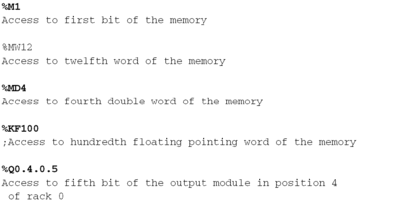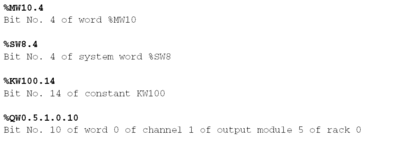Introduction
At a Glance
It is only possible to reference a data instance by address for certain data instances that belong to the EDT family. These instances are:
internal variables (%M<i>, %MW<i>, %MD<i>, %MF<i>)
constants (%KW<i>, %KD<i>, %KF<i>)
inputs/outputs (%I<address>, %Q<address>)
Reference by Direct Addressing
Addressing is considered direct when the address of the instance is fixed, or, in other words, when it is written into the program.
Examples:

References by Indexed Address
Addressing is considered indexed when the address of the instance is completed with an index.
The index is defined either by:
a value belonging to an Integer type
an arithmetical expression made up of Integer types
An indexed variable always has a non-indexed equivalent:

The rules for calculating <j> are as follows.
Object<i>[index] |
Object<j> |
|---|---|
%M<i>[index] |
<j>=<i> + <index> |
%MW<i>[index] |
<j>=<i> + <index> |
%KW<i>[index] |
<j>=<i> + <index> |
%MD<i>[index] |
<j>=<i> + (<index> x 2) |
%KD<i>[index] |
<j>=<i> + (<index> x 2) |
%MF<i>[index] |
<j>=<i> + (<index> x 2) |
%KF<i>[index] |
<j>=<i> + (<index> x 2) |
Examples:

During compilation of the program, a check verifies that:
the index is not negative
the index does not exceed the space in the memory allocated to each of these three data types
Word Extract Bits
It is possible to extract one of the 16 bits of single words (%MW, %SW; %KW, %IW, %QW).
The address of the instance is completed with the rank of the extracted bit (<j>).

Examples:

Byte Extract Bits
It is possible to extract one of the bits of a byte
The address of the extracted bit is accessible via:
The name of the corresponding byte.
The rank defining its position in the byte. (a number between 0 and 7)
Example:
MyByte is a variable of type BYTE. MyByte.i is a valid BOOL if 0 <= i <= 7
MyByte.0, MyByte.3 and MyByte.7 are valid BOOL.
MyByte.8 is invalid.
Creating a Structure type with extracted bit
The user can create structure type using extracted bit.
The Bit Rank dialog box is accessible by right clicking on the instance or data type which type must be:
WORD
UINT
INT
BYTE
an extracted bit with a compatible parent
Bit and Word Tables
These are a series of adjacent objects (bits or words) of the same type and of a defined length.

Presentation of bit tables:
Type |
Address |
Write access |
|---|---|---|
Discrete I/O input bits |
%Ix.<i>:L |
No |
Discrete I/O output bits |
%Qx.<i>:L |
Yes |
Internal bits |
%M<i>:L |
Yes |
Presentation of word tables:
Type |
Address |
Write access |
|---|---|---|
Internal words |
%MW<i>:L %MD<i>:L %MF<i>:L |
Yes |
Constant words |
%KW<i>:L %KD<i>:L %KF<i>:L |
No |
System words |
%SW50:4 |
Yes |
Examples:
%M2:65 Defines an EBOOL table from %M2 to %M66
%M125:30 Defines an INT table from %MW125 to %MW154


